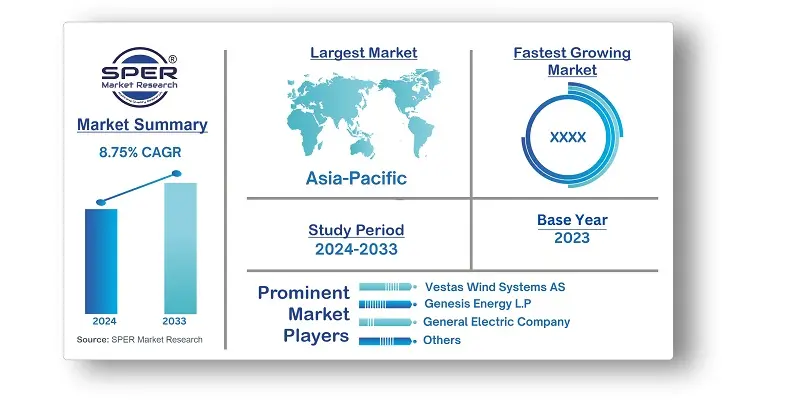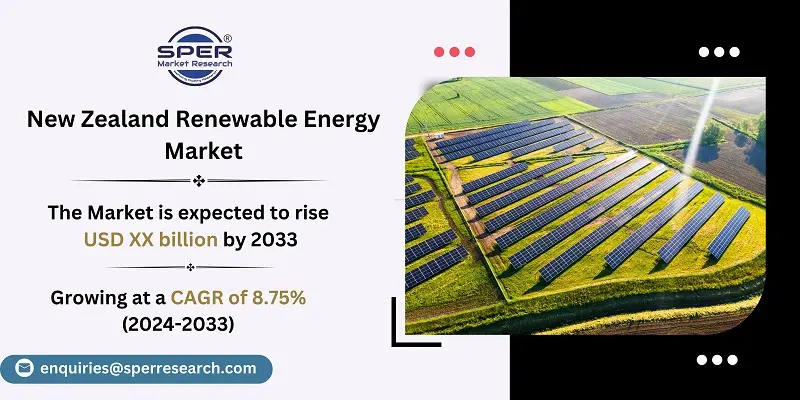
New Zealand Renewable Energy Market Trends, Share, Demand, Revenue and Future Outlook
New Zealand Renewable Energy Market Growth, Size, Trends Analysis- By Type, By End User- Regional Outlook, Competitive Strategies and Segment Forecast to 2033
| Published: Nov-2024 | Report ID: POAE2495 | Pages: 1 - 109 | Formats*: |
| Category : Power & Energy | |||
- In September 2021, Hive Energy, Ethical Power, and Solar South West (SSW) announced a joint venture (JV) to deploy approximately 350 MW of utility-scale photovoltaic (PV) capacity in New Zealand. The joint venture will collaborate to achieve the New Zealand government's goal of achieving 100 percent renewable energy generation by 2030.
- Castle Hill Wind Farm is an 860-megawatt onshore wind generating project. It is scheduled to take place in Manawatu-Wanganui, New Zealand. The project is now undergoing the permitting process. Genesis Energy is likely to develop it in one phase. The project is scheduled to be commissioned in 2024 once work is completed.

- Offshore Wind Energy: New Zealand has enormous offshore wind potential, and the building of offshore wind farms could help the country meet its renewable energy targets.
- Energy Storage Solutions: The intermittency problems of renewable energy sources can be resolved and grid stability improved by integrating energy storage technologies including batteries, pumped hydro storage, and thermal storage.
- Technological Developments: New developments in renewable energy technology have increased their cost-effectiveness and efficiency, putting them on par with more conventional energy sources.
- Problems with Intermittency and system Integration: Integrating renewable energy sources, such as wind and solar, into the existing power system and ensuring a consistent supply of electricity can be challenging due to its intermittent nature.
- Expensive initial outlay: Uptake may be restricted by the higher cost of installing renewable energy systems compared to conventional energy infrastructure, especially for small-scale installations.
- Permitting and regulatory obstacles: Renewable energy projects may face lengthy and complicated regulatory and permitting procedures, which could lead to delays and higher expenses.

| Report Metric | Details |
| Market size available for years | 2020-2033 |
| Base year considered | 2023 |
| Forecast period | 2024-2033 |
| Segments covered | By Type, By End User |
| Regions covered | Eastern, Western, Northern, Southern |
| Companies Covered | Contact Energy Limited, Vestas Wind Systems AS, Genesis Energy L.P, General Electric Company, Meridian Energy Ltd, Vector Limited, Mercury NZ Ltd, Siemens Gamesa Renewable Energy SA. |
- Government Agencies and Regulators
- Renewable Energy Companies and Developers
- Utility and Power Generation Companies
- Commercial and Industrial End-Users
- Financial Institutions and Investors
- Technology Providers and Equipment Manufacturers
- Consulting and Engineering Firms
- Research and Academic Institutions
- Agriculture and Rural Sector Stakeholders
- Residential and Small-Scale Energy Consumers
| By Type: | |
| By End User: | |
| By Region: |
- New Zealand Renewable Energy Market Size (FY’2024-FY’2033)
- Overview of New Zealand Renewable Energy Market
- Segmentation of New Zealand Renewable Energy Market By Type (Geothermal, Hydro, Wind, Solar, others types)
- Segmentation of New Zealand Renewable Energy Market By End User (Residential, Commercial, Industrial)
- Statistical Snap of New Zealand Renewable Energy Market
- Expansion Analysis of New Zealand Renewable Energy Market
- Problems and Obstacles in New Zealand Renewable Energy Market
- Competitive Landscape in the New Zealand Renewable Energy Market
- Impact of COVID-19 and Demonetization on New Zealand Renewable Energy Market
- Details on Current Investment in New Zealand Renewable Energy Market
- Competitive Analysis of New Zealand Renewable Energy Market
- Prominent Players in the New Zealand Renewable Energy Market
- SWOT Analysis of New Zealand Renewable Energy Market
- New Zealand Renewable Energy Market Future Outlook and Projections (FY’2024-FY’2033)
- Recommendations from Analyst
1.1. Scope of the report1.2. Market segment analysis
2.1. Research data source
2.1.1. Secondary Data2.1.2. Primary Data2.1.3. SPER’s internal database2.1.4. Premium insight from KOL’s
2.2. Market size estimation
2.2.1. Top-down and Bottom-up approach
2.3. Data triangulation
4.1. Driver, Restraint, Opportunity and Challenges analysis
4.1.1. Drivers4.1.2. Restraints4.1.3. Opportunities4.1.4. Challenges
4.2. COVID-19 Impacts of the New Zealand Renewable Energy Market
5.1. SWOT Analysis
5.1.1. Strengths5.1.2. Weaknesses5.1.3. Opportunities5.1.4. Threats
5.2. PESTEL Analysis
5.2.1. Political Landscape5.2.2. Economic Landscape5.2.3. Social Landscape5.2.4. Technological Landscape5.2.5. Environmental Landscape5.2.6. Legal Landscape
5.3. PORTER’s Five Forces
5.3.1. Bargaining power of suppliers5.3.2. Bargaining power of buyers5.3.3. Threat of Substitute5.3.4. Threat of new entrant5.3.5. Competitive rivalry
5.4. Heat Map Analysis
6.1. New Zealand Renewable Energy Market Manufacturing Base Distribution, Sales Area, Product Type6.2. Mergers & Acquisitions, Partnerships, Product Launch, and Collaboration in New Zealand Renewable Energy Market
7.1. New Zealand Renewable Energy Market Size, Share and Forecast, By Type, 2020-20267.2. New Zealand Renewable Energy Market Size, Share and Forecast, By Type, 2027-20337.3. Geothermal7.4. Hydro7.5. Wind7.6. Solar7.7. Other Types
8.1. New Zealand Renewable Energy Market Size, Share and Forecast, By End User, 2020-20268.2. New Zealand Renewable Energy Market Size, Share and Forecast, By End User, 2027-20338.3. Residential8.4. Commercial8.5. Industrial
9.1. New Zealand Renewable Energy Market Size and Market Share
10.1. New Zealand Renewable Energy Market Size and Market Share By Region (2020-2026)10.2. New Zealand Renewable Energy Market Size and Market Share By Region (2027-2033)10.3. Eastern10.4. Western10.5. Northern10.6. Southern
11.1. Contact Energy Limited
11.1.1. Company details11.1.2. Financial outlook11.1.3. Product summary11.1.4. Recent developments
11.2. Vestas Wind Systems AS
11.2.1. Company details11.2.2. Financial outlook11.2.3. Product summary11.2.4. Recent developments
11.3. Genesis Energy L.P
11.3.1. Company details11.3.2. Financial outlook11.3.3. Product summary11.3.4. Recent developments
11.4. General Electric Company
11.4.1. Company details11.4.2. Financial outlook11.4.3. Product summary11.4.4. Recent developments
11.5. Meridian Energy Ltd
11.5.1. Company details11.5.2. Financial outlook11.5.3. Product summary11.5.4. Recent developments
11.6. Vector Limited
11.6.1. Company details11.6.2. Financial outlook11.6.3. Product summary11.6.4. Recent developments
11.7. Mercury NZ Ltd
11.7.1. Company details11.7.2. Financial outlook11.7.3. Product summary11.7.4. Recent developments
11.8. Siemens Gamesa Renewable Energy SA
11.8.1. Company details11.8.2. Financial outlook11.8.3. Product summary11.8.4. Recent developments
11.9. Others
SPER Market Research’s methodology uses great emphasis on primary research to ensure that the market intelligence insights are up to date, reliable and accurate. Primary interviews are done with players involved in each phase of a supply chain to analyze the market forecasting. The secondary research method is used to help you fully understand how the future markets and the spending patterns look likes.
The report is based on in-depth qualitative and quantitative analysis of the Product Market. The quantitative analysis involves the application of various projection and sampling techniques. The qualitative analysis involves primary interviews, surveys, and vendor briefings. The data gathered as a result of these processes are validated through experts opinion. Our research methodology entails an ideal mixture of primary and secondary initiatives.



Frequently Asked Questions About This Report
PLACE AN ORDER
Year End Discount
Sample Report
Pre-Purchase Inquiry
NEED CUSTOMIZATION?
Request CustomizationCALL OR EMAIL US
100% Secure Payment






Related Reports
Our Global Clients
Our data-driven insights have influenced the strategy of 200+ reputed companies across the globe.




















